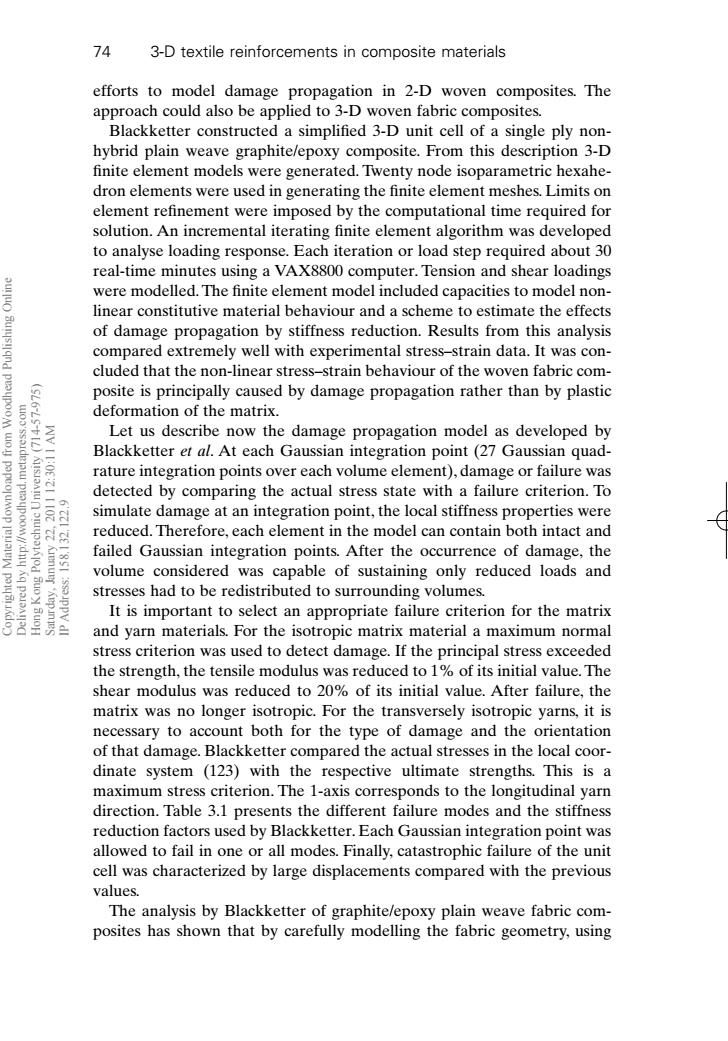正在加载图片...

74 3-D textile reinforcements in composite materials efforts to model damage propagation in 2-D woven composites.The approach could also be applied to 3-D woven fabric composites. Blackketter constructed a simplified 3-D unit cell of a single ply non- hybrid plain weave graphite/epoxy composite.From this description 3-D finite element models were generated.Twenty node isoparametric hexahe- dron elements were used in generating the finite element meshes.Limits on element refinement were imposed by the computational time required for solution.An incremental iterating finite element algorithm was developed to analyse loading response.Each iteration or load step required about 30 real-time minutes using a VAX8800 computer.Tension and shear loadings were modelled.The finite element model included capacities to model non- linear constitutive material behaviour and a scheme to estimate the effects of damage propagation by stiffness reduction.Results from this analysis compared extremely well with experimental stress-strain data.It was con- cluded that the non-linear stress-strain behaviour of the woven fabric com- posite is principally caused by damage propagation rather than by plastic deformation of the matrix. Let us describe now the damage propagation model as developed by Blackketter et al.At each Gaussian integration point (27 Gaussian quad- 银 rature integration points over each volume element),damage or failure was detected by comparing the actual stress state with a failure criterion.To 日 simulate damage at an integration point,the local stiffness properties were reduced.Therefore,each element in the model can contain both intact and failed Gaussian integration points.After the occurrence of damage,the volume considered was capable of sustaining only reduced loads and stresses had to be redistributed to surrounding volumes. PPV It is important to select an appropriate failure criterion for the matrix 8 and yarn materials.For the isotropic matrix material a maximum normal stress criterion was used to detect damage.If the principal stress exceeded the strength,the tensile modulus was reduced to 1%of its initial value.The shear modulus was reduced to 20%of its initial value.After failure,the matrix was no longer isotropic.For the transversely isotropic yarns,it is necessary to account both for the type of damage and the orientation of that damage.Blackketter compared the actual stresses in the local coor- dinate system (123)with the respective ultimate strengths.This is a maximum stress criterion.The 1-axis corresponds to the longitudinal yarn direction.Table 3.1 presents the different failure modes and the stiffness reduction factors used by Blackketter.Each Gaussian integration point was allowed to fail in one or all modes.Finally,catastrophic failure of the unit cell was characterized by large displacements compared with the previous values. The analysis by Blackketter of graphite/epoxy plain weave fabric com- posites has shown that by carefully modelling the fabric geometry,usingefforts to model damage propagation in 2-D woven composites. The approach could also be applied to 3-D woven fabric composites. Blackketter constructed a simplified 3-D unit cell of a single ply nonhybrid plain weave graphite/epoxy composite. From this description 3-D finite element models were generated. Twenty node isoparametric hexahedron elements were used in generating the finite element meshes. Limits on element refinement were imposed by the computational time required for solution. An incremental iterating finite element algorithm was developed to analyse loading response. Each iteration or load step required about 30 real-time minutes using a VAX8800 computer. Tension and shear loadings were modelled. The finite element model included capacities to model nonlinear constitutive material behaviour and a scheme to estimate the effects of damage propagation by stiffness reduction. Results from this analysis compared extremely well with experimental stress–strain data. It was concluded that the non-linear stress–strain behaviour of the woven fabric composite is principally caused by damage propagation rather than by plastic deformation of the matrix. Let us describe now the damage propagation model as developed by Blackketter et al. At each Gaussian integration point (27 Gaussian quadrature integration points over each volume element), damage or failure was detected by comparing the actual stress state with a failure criterion. To simulate damage at an integration point, the local stiffness properties were reduced. Therefore, each element in the model can contain both intact and failed Gaussian integration points. After the occurrence of damage, the volume considered was capable of sustaining only reduced loads and stresses had to be redistributed to surrounding volumes. It is important to select an appropriate failure criterion for the matrix and yarn materials. For the isotropic matrix material a maximum normal stress criterion was used to detect damage. If the principal stress exceeded the strength, the tensile modulus was reduced to 1% of its initial value. The shear modulus was reduced to 20% of its initial value. After failure, the matrix was no longer isotropic. For the transversely isotropic yarns, it is necessary to account both for the type of damage and the orientation of that damage. Blackketter compared the actual stresses in the local coordinate system (123) with the respective ultimate strengths. This is a maximum stress criterion. The 1-axis corresponds to the longitudinal yarn direction. Table 3.1 presents the different failure modes and the stiffness reduction factors used by Blackketter. Each Gaussian integration point was allowed to fail in one or all modes. Finally, catastrophic failure of the unit cell was characterized by large displacements compared with the previous values. The analysis by Blackketter of graphite/epoxy plain weave fabric composites has shown that by carefully modelling the fabric geometry, using 74 3-D textile reinforcements in composite materials RIC3 7/10/99 7:37 PM Page 74 Copyrighted Material downloaded from Woodhead Publishing Online Delivered by http://woodhead.metapress.com Hong Kong Polytechnic University (714-57-975) Saturday, January 22, 2011 12:30:11 AM IP Address: 158.132.122.9